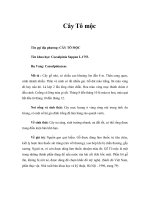Tài liệu Travel to Barcelona pdf
Bạn đang xem bản rút gọn của tài liệu. Xem và tải ngay bản đầy đủ của tài liệu tại đây (5.84 MB, 58 trang )
Download free ebooks at bookboon.com
Download free ebooks at bookboon.com
Barcelona
© 2008 Stig Albeck & Ventus Publishing ApS
Translation: Cecilia Byrnak
All rights and copyright relating to the content of this
book are the property of Ventus Publishing ApS, and/or its
suppliers. Content from ths book, may not be reproduced
in any shape or form without prior written permission from
Ventus Publishing ApS.
Quoting this book is allowed when clear references are made,
in relation to reviews are allowed.
ISBN 978-87-7061-308-8
1st edition
Pictures and illustrations in this book are reproduced according
to agreement with the following copyright owners:
Eva Lis Petersen & Spanish Tourist Council.
The stated prices and opening hours are indicative and may
have been subject to change after this book was published.
Download free ebooks at bookboon.com
Barcelona
4
Kapiteloverskrift ONLIBRI
Download free ebooks at bookboon.com
Barcelona
5
A visit to Barcelona
Barcelona is the capital of Catalonia with 2,5 million
citizens and a spectacular location by the warm coast
of the Mediterranean. You are in Spain, but
throughout the years, the history and culture of
Catalonia have put their evident mark on the city
and the rest of Catalonia. Amazing construction
works have through the years been built in the old
neighbourhoods. Barcelona and modernism
automatically make you think of the world-renowned
architect Antonio Gaudí. Barcelona is his city and
his fingerprints are everywhere. His masterpieces
such as la Sagrada Familia, Casa Mila and Park Güell
are famous, but do also notice his works around the
city.
Barcelona is beautifully placed in hilly country that
offers plenty of opportunities for wonderful trips
with one sight after another. In the central
Barcelona, but also towards both the north and
south, kilometres of sandy beaches go on and on,
ready to invite you into the Mediterranean waves.
Have a nice trip!
A visit to Barcelona
Download free ebooks at bookboon.com
Barcelona
6
Historical outline
The first sure signs of habitation are the Roman
foundation of Barcelona in 218 BC. Any earlier
habitation is not documented. When the Roman
Empire dissolved in 400 the Romans left Barcelona.
In the following 500 years, the reign of the city
shifted hands several times. Not before the 900s did
it become capital of the area in and around the
present Catalonia. Based on the laws of Rome, the
city gradually evolved and throughout the centuries,
Barcelona became an even greater rival of the
Madrid domination of Spain.
In 1479 the cities were joined when Ferdinand
married Isabella of Castille, which set new grounds
for the competition between the cities. For instance,
Madrid ordered Barcelona not to trade with the new
colonies in America. At the end of the 1600s
Catalonia declared war against Spain and claimed
independence. This happened under the protection
of France. The Spanish troops led by the Castille
besieged Barcelona and conquered the city. In 1713,
the War of the Spanish Succession began and
Barcelona supported the losing party. A result hereof
was the Spanish besiege of the city in 1713-1714.
After the defeat, the city was ordered to abolish its
regional government and simultaneously the Citadel
was built to supervise Barcelona onwards.
The Catalonian language was, at the same time,
forbidden. In the beginning of the 1800s, the city re-
flourished. The trade with the American colonies
was once again legalised, and after Napoleon’s defeat
and the following withdrawal from Spain, the
industrial development in Barcelona flourished just
as in other places of the country.
The first railroad of Spain was built from Barcelona
to Matero. Among other things a larger production
of wine and an iron industry were also developed.
The population of the city gradually increased and
in 1869 there was a large expansion of the city
districts. You can still see the city plan of that year
in the area around Plaza Catalunya.
In the beginning of the 1900s, the self-image of
Catalonia rose again and republican thoughts were
subject of increasing value to many local groups.
The Spanish leader, Prima de Rivera, band some
political units and other Catalonian institutions,
such as the football club FC Barcelona, were shut
down. After Rivera's fall in 1931, the nationalists of
Catalonia declared Catalonia independent, but this
was withdrawn after much pressure from Madrid.
The former regional government was reinstated, but
shut again, already in 1934, after political attempts
of seceding Catalonia. Immediately before the
imminent Spanish Civil War, another regional
government was formed.
When Franco's troops, in the first period of the
civil war, quickly emerged from the southern Spain,
Barcelona stood by the republic with Madrid which
fell. The Spanish government fled to Barcelona and
shortly hereafter Franco's troops were just outside
the city. The first aerial bombardments started in
1938 and in January 1939 the city fell. Spain was,
once again, united under a government in Madrid.
The language of Catalonia was again prohibited and
every street name in the city was now written in
Spanish.
Historical outline
Download free ebooks at bookboon.com
Barcelona
7
Through the years up until Franco's death the
development in Spain continued. This caused a
financial boom, not at least because of an increase in
international tourism to many Spanish locations e.g.
Costa Brava outside Barcelona. After Franco's death
in 1975, Catalonian politicians in exile returned to
Barcelona and with King Juan Carlos accession
autonomy was formed in Catalonia and the regional
government reinstated.
Barcelona joined the rest of Spain in the UN in the
1980s and this started a financial and cultural
development the city had not experienced before.
The international highlight came in 1992 when the
city was chosen to hold the Olympic Games. The
construction work and investments related to the
games meant a continuation of the growth period
into the city you meet today
Historical outline
Download free ebooks at bookboon.com
Please click the advert
Barcelona
8
Tour 1: Barcelona
1. Plaça de Catalunya
Plaça de Catalunya
Metro: Catalunya
The Catalunya square is the centre of Barcelona and
it is where the old part of the city meets the
Eixampe-district of the 18
th
century. The
forerunner of the current square was arranged in
1859. This is where several of Barcelona's wide
streets branch from e.g. the pedestrian streets La
Rambla and Passeig de Grácia. There are several
works of art on Plaça de Catalunya and the open
areas and beautiful fountains always attract both
tourists and locals.
Tour 1: Barcelona
Download free ebooks at bookboon.com
Barcelona
9
2. La Rambla
La Rambla
Metro: Catalunya/Liceu/Drassanes
La Rambla is the beautiful pedestrian street of
Barcelona and everyone should stroll along and
experience the life of the city. On the 1.2 kilometres
long Rambla, you will find shady trees, flower
markets, artists, shops, restaurants, many interesting
buildings and an always lovely atmosphere.
3. Museu d'Art Contemporani
Plaça dels Àngels 1
www.macba.es
Metro: Catalunya/Universitat
Museu d’Art Contemporani is the museum of
modern art in Barcelona. The great white building
was built from 1987 to 1995 and is inspired by
Modernism. Three periods are represented; 1940-
1960, 1960-1970, and finally the latter decades. The
collection focuses on art of Catalonia and the rest
of Spain
4. Església de Betlem
La Rambla
Metro: Catalunya
The Bethlehem church, Església de Betlem, is one
of the few baroque buildings in Barcelona. It was
originally part of a Jesuit convent. The church was
built in 1553, but burned to the ground in 1936
during the Spanish Civil War. Església de Betlem
was reconstructed on the outside, while the interior
was not rebuilt as the church from the 16
th
century.
5. Palau de la Virreina (La Rambla 99)
La Rambla 99
www.bcn.es/virreinaexposicions
Metro: Liceu
The 18
th
century palace, Palau de la Virreina, is one
of the best examples of civilian Catalonian
architecture of this period. Today, the house
belongs to the city council and it is used for
exhibitions.
6. Mercat de la Boqueria
La Rambla
www.boqueria.info
Metro: Liceu
Tour 1: Barcelona
Download free ebooks at bookboon.com
Barcelona
10
Mercat de la Boqueria is a large market, which
spreads immediately behind a row of house façades
on La Rambla. One market here can be traced back
to the 13
th
century when agricultural products were
sold in this very spot; this was right outside the city.
Today’s market was opened in 1853 and large parts
of the market halls are from 1914
7. Miró Mosaic (La Rambla)
La Rambla
Metro: Liceu
Approximately in the middle of the Rambla, where
the street Carrer de l'Hospital meets La Rambla, you
can see a big and beautiful pavement mosaic done by
Joan Miró. The colourful work of art is from 1976.
8. Santa Maria del Pi
Calle Cardenal Casañas 16
Metro: Liceu
The church Santa Maria del Pi was constructed in
the 1300s, in a place supposedly used for religious
buildings since the 400s. The church is built with a
rosette window in the gable and amazing glass
mosaics in the large church room measuring 54
meters in length and 27 meters to the ceiling
9. Gran Teatre del Liceu
La Rambla 51-59
www.liceubarcelona.com
Metro: Liceu
Gran Teatre del Liceu is Barcelona's opera. The
building was constructed in 1845-1847 after a
private society collection. The opera burned down
in 1861 and was rebuilt the following year. Then
again in 1994, a fire destroyed major parts of the
theatre which today is rebuilt as similar to the
original as possible. Some parts are still from the
original construction e.g. the façade. Almost 2300
spectators can be accommodated; making Liceu one
of the largest opera houses in Europe.
10. Plaça Reial
Plaça Reial
Metro: Liceu
One of the most beautiful and harmonic squares of
Barcelona is the royal square Plaça Reial that was
arranged in the very spot in which a convent
burned down in the 1800s. The buildings around
the rectangular square were built in 1848-1895.
Quite rapidly, the square with its benches, lean palm
trees, fountains and lampposts made by Antonio
Gaudí became a very popular place to the
townsmen. This is evident even today and especially
at night there is an intriguing atmosphere
Tour 1: Barcelona
Download free ebooks at bookboon.com
Please click the advert
Barcelona
11
11. Palau Güell
Calle Nou de la Rambla 3-5
Metro: Liceu
Palau Güell is the first great construction by Antonio
Gaudí, built in 1888. The works of Gaudí in the city
are on the UNESCO World Heritage List and even
though they are inspired by, for instance Gothic and
Mauri style, Gaudí's style is one of a kind. The house
was built for the Güell family with industrial
magnate Eusebi Güell in front. It was a private
residence and especially the reception facilities are
interesting
12. Museu de Cera
Passatge de la Banca 7
www.museucerabcn.com
Metro: Drassanes
Museu de Cera is Barcelona's wax museum with
more than 350 figures of persons from very different
parts of history. The building itself is also quite
noticeable.
13. Monument a Colom
Tour 1: Barcelona
© Deloitte & Touche LLP and affiliated entities.
360°
thinking
.
Discover the truth at www.deloitte.ca/careers
© Deloitte & Touche LLP and affiliated entities.
360°
thinking
.
Discover the truth at www.deloitte.ca/careers
© Deloitte & Touche LLP and affiliated entities.
360°
thinking
.
Discover the truth at www.deloitte.ca/careers
© Deloitte & Touche LLP and affiliated entities.
360°
thinking
.
Discover the truth at www.deloitte.ca/careers
Download free ebooks at bookboon.com
Barcelona
12
Plaça Portal de la Pau
Metro: Drassanes
The 60 meters high Columbus monument,
Monument a Colom, is set at the end of La Rambla
facing Barcelona's harbour and the Mediterranean.
The surrounding square was arranged in 1849, when
the city wall sheltering the Rambla from the harbour
was torn down. The monument was built in the
years 1881-1888 in memory of Christopher
Columbus' visit with King Ferdinand and Isabella in
Barcelona, in 1493.
14. Golondrines
Plaça Portal de la Pau 1
www.lasgolondrinas.com
Metro: Drassanes
Golondrines is the name of the tour boats sailing the
harbour of Barcelona. A normal sightseeing trip
takes approximately 35 minutes.
15. Aduana Vieja
Passeig de Josep Carner
Metro: Drassanes
Aduana Vieja is Barcelona’s old custom house
constructed in fashionably decorated style in the
years 1896-1902
16. Museu Marítim
Avinguda de les Drassanes
www.museumaritimbarcelona.com
Metro: Drassanes
The Barcelona navy museum, Museu Marítim, has
since the foundation in 1929 been instrumental in
bringing about mainly the maritime history of
Catalonia. In the collection there are interesting
ships and a long row of objects such as model ships,
nautical instruments and charts. One of the
absolute highlights of the museum is a replica of a
16
th
century ship that was used in the battle at sea
against the Turks at Lapanto in 1572. Along the
street Avenida del Parallel, immediately south of the
navy museum in a green area, you can see a
preserved part of now cancelled and destroyed city
walls of Barcelona
17. Torre Jaume I
Moll 18
www.tmb.net
Metro: Drassanes
Tour 1: Barcelona
Download free ebooks at bookboon.com
Barcelona
13
The 107 meters high tower Torre Jaume I was built
in 1931 as an aerial ropeway station for the track. An
unforgettable trip leads from the 78 meters high
tower, Torre Sant Sebastia, via Torre Jaumes I to
Montjuïc. The ropeway is called Teleférico de
Montjuïc. From the tower itself, there is an
absolutely spectacular view of Barcelona and the
harbour area. The highly recommended aerial trip
puts it all in perspective.
Tour 1: Barcelona
Download free ebooks at bookboon.com
Please click the advert
Barcelona
14
Tour 2: Barcelona
18. Palau Centelles
Baixada de Sant Miquel 8
Metro: Jaume I
Palau Centelles was built in the 1500s as a palace for
the king. The building later passed to the regional
government of Catalonia, Generalitet. You are not
allowed to see the interior of the palace, however,
take a stroll in the yard; an impressive oasis in
Gothic and Renaissance style.
19. Palau de Requessens
Calle Bisbe Caçador 3
Metro: Jaume I
Palau de Requesens is the greatest nobleman’s
estate from the Middle Ages’ Barcelona. It was built
in 13
th
century with an interesting integration of the
Roman city wall in the complex. In the 17
th
century
the palace was partially rebuilt and extended; e.g.
with a balcony facing the street. In the 16
th
century,
Catalonia’s governor-general and friend of King
Felipe 2
nd
, Galceran de Requesens, lived here. Since
1970, the building has been a Catalonian cultural
institute; Galaria de Catalans Illustres, with portraits
of famous Catalonians. You can also see exhibitions
arranged by Reial Académia de Bones Lletres.
Tour 2: Barcelona
Increase your impact with MSM Executive Education
For more information, visit www.msm.nl or contact us at +31 43 38 70 808
or via
the globally networked management school
For more information, visit www.msm.nl or contact us at +31 43 38 70 808 or via
For almost 60 years Maastricht School of Management has been enhancing the management capacity
of professionals and organizations around the world through state-of-the-art management education.
Our broad range of Open Enrollment Executive Programs offers you a unique interactive, stimulating and
multicultural learning experience.
Be prepared for tomorrow’s management challenges and apply today.
Executive Education-170x115-B2.indd 1 18-08-11 15:13
Download free ebooks at bookboon.com
Barcelona
15
20. Plaça de Sant Jaume
Plaça de Sant Jaume
Metro: Jaume I
The Sant Jaume square is where the two most
important roads of the Roman city intersected. The
importance of the square is signified by the fact that
the two most significant political institutions are
placed here.
20a. Ajuntament
www.bcn.cat
Ajuntament is the city hall of Barcelona and with its
beautiful modern classicism façade it faces Plaça de
sant Jaume. The central entrance is flanked by two
statues of Jaume 1
st
and chancellor Joan Fiveller.
Inside the building you will find several gorgeous
halls e.g. the one that houses one of the city’s tourist
information centres.
20b. Palau de la Generalitet
Generalitet is the name of the old regional
government of Catalonia, which now uses the palace,
Palau de la Generalitet, which originally was built in
the early 15
th
century. Throughout time, several
reconstructions and additional buildings have been
made.
21. Catedral
Plaça de la Seu
www.website.es/catedralbcn
Metro: Jaume I
The impressive cathedral of Barcelona was
commenced in 1298 and opened in 1454, however,
not yet finished. The façade of the cathedral is the
most recently finished; it was done in 1890. The
cathedral is one of the masterpieces of Spanish
Gothic and an amazing display of detail can be
found both outside and inside. Among the most
spectacular are the high altar, the bell tower from
the 15
th
century and the crypt in which one of two
of Barcelona's guardian angels, Santa Eulália, lies. In
this spot, there was already a Christian basilica from
the fourth century which was ruined in 958
Tour 2: Barcelona
Download free ebooks at bookboon.com
Barcelona
16
22. Museu Diocesà
Avinguda de la Catedral 4
www.arquebisbat.bcn.cat
Metro: Jaume I
Museu Diocesà exhibits different religious art from
the Middle Ages up until today. You can see
sculptures, paintings, jewellery etc.
23. Museu Frederic Marès
Plaça Sant Iu 5-6
www.muesumares.bcn.cat
Metro: Jaume I
This museum was established in 1946 by sculptor
Frederic Marés who had a collection of works. The
museum department for Spanish art displays works
from the Roman era to the 20
th
century and is, in its
field, among the most prominent in the country
24. Plaça del Rei
Plaça del Rei
Metro: Jaume I
Plaça del Rei is the architectural centre of the old
quarter of Barcelona. Surrounding the square are
medieval Gothic buildings with the former royal
palace at head. The palace tower, Torre Mirador del
ReiMartí, rises as a true skyscraper of the 16
th
century.
24a. Palau Reial Major
Palau Reial Major is the former royal palace of
Catalonia. The earliest part of the building can be
traced back to the 13
th
century. The place was also
the administrative centre back in the days of the
Roman reign. The central room of the palace, Saló
del Tinell, is an especially beautiful banquet hall
from 1362.
24b. Palau del Lloctinent
Palau del Lloctinent was built in 1549-1557 in the
capital of Catalonia as residence for the viceroy.
However, for centuries the palace was used for
storing royal belongings. The style is late Gothic
with some renaissance elements, which are seldom
seen in this city.
24c. Capilla Reial de Santa Àgueda
Capilla Reial de Santa Àgueda is the chapel of the
royal palace devoted to Santa Agatha. It was built in
the 14
th
century.
24d. Museu d´Historia de la Ciutat
www.museuhistoria.bcn.es
The city museum of Barcelona is particularly
interesting. The entire history of the city, from the
Roman era until the present, is told in images, text
and models. In the basement, you can see the
archaeological excavations of the Roman city. They
began in 1931 and you can see remains of the first
city wall, streets and different buildings.The
museum is organized in Casa Clariana-Padellas; a
Gothic commercial house built in the 16
th
century.
Tour 2: Barcelona
Download free ebooks at bookboon.com
Please click the advert
Barcelona
17
25. Plaça de Ramon Berenguer el
Gran
Plaça de Ramon Berenguer el Gran
Metro: Jaume I
This square was arranged in 1922 outside the
Roman old walls and from here there is a
spectacular view of the very well preserved part of
the old defence. Barcelona's Roman walls for
defence were built in the fifth century. They are
nine meters tall and more than 3,5 meters thick.
You can still see many of the watchtowers
protecting the city integrated in the walls. The walls
were left untouched until the 14
th
century when it
was allowed to build up against the walls to avoid
lack of space in the town
Tour 2: Barcelona
Get “Bookboon’s Free Media Advice”
See the light!
The sooner you realize we are right,
the sooner your life will get better!
A bit over the top? Yes we know!
We are just that sure that we can make your
media activities more effective.
Download free ebooks at bookboon.com
Barcelona
18
Tour 2: Barcelona
Download free ebooks at bookboon.com
Barcelona
19
Tour 3: Barcelona
26. Casa Calvet
Carrer de Casp 48
Metro: Urquinaona
Casa Calvet was built by Antonio Gaudí in the years
1898-1904 as a residence to textile manufacturer,
Don Pedro Mártir Calvet. The façade is symmetrical,
atypical of Gaudí, however, his characteristic details
in the architecture are quite evident.
27. Casa Lleó-Morera
Passeig de Gràcia 35
Metro: Passeig de Gracia
The corner building, Casa Lleó-Morera, from 1902-
1906, is one of the most richly decorated modern
houses in Barcelona. Combined with the adjacent
houses, Casa Battló and Casa Amattler, it forms a
fine trilogy of this era.
28. Casa Amattler
Passeig de Gràcia 41
Metro: Passeig de Gracia
Casa Amattler was built in the years 1898-1900 and
the modern architecture was inspired by Nordic
Gothic; e.g. the jagged gable towards the street.
29. Casa Battló
Passeig de Gràcia 43
Metro: Passeig de Gracia
Casa Battló is one of Antonio Gaudí's famous
houses. It was originally built in 1877 and totally
rebuilt by Gaudí in 1905 – 1907. As some of his
other buildings, the house seems almost alive in its
form of expression. In the design, which is Gaudí’s
particular form of Art Nouveau, barely any straight
lines occur. A huge part of the façade is decorated
with broken ceramic tiles in various colours. By
Casa Battló, lie the interesting houses Casa Lleo
Tour 3: Barcelona
Download free ebooks at bookboon.com
Please click the advert
Barcelona
20
Morera (rebuilt in 1906) and Casa Amattler (rebuilt
in 1896). The three houses are collectively called
“Houses of Strife” because they differ a lot in
expression, but are placed so closely together.
30. Casa Milà
Passeig de Gràcia 92
www.casamila.com
Metro: Diagonal
The house Casa Milá from 1905-1907 is one of
Antonio Gaudí's most renowned buildings. The
most characteristic about this creation in particular
is the undulating façade which has given inspiration
to other houses around the world; e.g.
Hundertwasserhaus in Vienna. Visitors should grant
themselves a visit to the top storey and the
furnished apartment.
Tour 3: Barcelona
GO T -THE-ENER GY -TO-LEAD.COM
We believe that energy suppliers should be renewable, too. We are therefore looking for enthusiastic
new colleagues with plenty of ideas who want to join RWE in changing the world. Visit us online to find
out what we are offering and how we are working together to ensure the energy of the future.
Download free ebooks at bookboon.com
Barcelona
21
31. Casa Terrades o Casa de les
Punxes
Avinguda Diagonal 416
Metro: Diagonal/Verdaguer
Two constructions hide behind the name of this
tower-ornamented and castle-like complex: The
residence of the Terrades sisters and Casa de les
Punjex; one of the most special compositions from
Modernism. The estates were built in 1903-1905.
32. Palau Baró de Quadras
Avinguda Diagonal 373
Metro: Diagonal
This house is one of the more characteristic houses
of Barcelona's Modernism. Built in 1904-1906, it is
inspired by Gothic houses.
33. Casa Comalat
Avinguda Diagonal 442
Metro: Diagonal
Casa Comalat is one of Barcelona's modern houses,
which makes some compare it to Atonio Gaudí.
However, it was designed by Salvador Valeri in
1906-1911.
34. Casa Vicens
Carrer de les Carolines 24
www.casavicens.es
Metro: Lesseps
Tour 3: Barcelona
Download free ebooks at bookboon.com
Barcelona
22
The estate Casa Vicens is the first great construction
work of Antonio Gaudí. Built in 1883-1885, it was
the residence of industrial magnate Manuel Vicens,
who owned, among other things, a ceramics- and tile
factory. Using these exact materials on the house
was therefore natural. Today, the house is a private
home.
35. Park Güell
Carrer d’Olot
Metro: Lesseps
Park Güell is a 17 hectare large park designed by
Antonio Gaudí and arranged in 1900-1914. Founder
Eusebi Güell had originally intended the park as a
place for estates of the prosperous but only two of
sixty homes were built. Though Gaudí did not
design the estates, he was persuaded by Güell to
move in here himself in Torre Rosa. This is now
known as Casa Museu Gaudí. The central element of
the park is the grand terrace with a famous bench in
the shape of a sea serpent. Even the paths of the
park are interesting and from the top of the hill there
is a magnificent view of Barcelona.
36. Parc del Laberint d’Horta
Passeig Castanyers 1
Metro: Mundet
This is the oldest public park in Barcelona and a
fine example of a 18
th
century garden. The park is
divided into different terraces and includes a big
maze of plants in the middle.
Tour 3: Barcelona
Download free ebooks at bookboon.com
Please click the advert
Barcelona
23
Tour 3: Barcelona
Contact us to hear more
Who is your target group?
And how can we reach them?
At Bookboon, you can segment the exact right
audience for your advertising campaign.
Our eBooks offer in-book advertising spot to reach
the right candidate.
Download free ebooks at bookboon.com
Barcelona
24
Tour 4: Barcelona
37. Palau de la Música Catalana
Calle Sant Pere Més Alt
www.palaumusica.org
Metro: Urquinaona
Barcelona is known for its Modernism; a unique
forerunner of European Jugend style. The building
Palau de Música Catalana is one of the main works
and included in the UNESCO World Heritage List.
It opened in 1908 after almost three years of work.
Inside you will find a long row of details in the
colourful and almost living house. It was originally
built to house a choir, but a lot of concerts are now
held there as well.
38. Museu Barbier-Mueller d’Art
Precolombí
Carrer de Montcada 12-14
www.barbier-mueller.ch/cat/plansca.html
Metro: Jaume I
In the Barbier-Mueller Museum they have a fine
collection of Pre-Columbian art. The collection
includes most styles from the old American art and
among the pieces ceramics, sculptures, textiles and
different ritual effects are to be seen here.
39. Museu Picasso
Carrer de Montcada 15-23
www.museupicasso.bcn.es
Metro: Jaume I
The artist Pablo Picasso lived in Barcelona for nine
years when his family had moved there from
Malaga. In these years, he went through his so-
called blue period and painted some of the first
great works of art. The Picasso Museum opened in
1963 and the collection includes pieces from most
of the years of his artistry. All in all, more than 3500
pieces are exhibited, so it is a very comprehensive
collection.
40. Església de Santa Maria del Mar
Passeig del Born 1
Metro: Jaume I
The Santa Maria del Mar church is thought to be
one of the finest examples of Catalonian Gothic.
Inside, the building is arranged quite simply. It gives
the impression that it is filled with pillars and
windows. The rosette window in the gable is from
the 15
th
century.
41. Parc de la Ciutadella
Parc de la Ciutadella
www.parlament-cat.net
Metro: Ciatudella Vila Olimpíca/Arc de Triomf
The Citadel park is one of the large city parks in
central Barcelona. As the name indicates there was
formerly a citadel here. It was torn down in the
middle of the 19
th
century. In 1888, the park
became home to the world exhibition. The green
area with avenues, a lake and gorgeous gardens is
just wonderful for a walk. The largest building in
the park is almost castle-like and houses the
Parliament of Catalonia. You will also find
Barcelona's Zoo here.
Tour 4: Barcelona
Download free ebooks at bookboon.com
Barcelona
25
42. Arc de Triomf
Plaça de l´Arc de Triomf
Metro: Arc de Triomf
The triumphal arch, Arc de Triomf, was built as a
gateway to the world exhibition held in Barcelona in
1888. The style is New-Mauri and richly ornamented.
In the top you can see Barcelona's escutcheon and
over the round arch the 49 of the other Spanish
provinces.
43. Plaça de Toros Monumental
Plaça de Toros Monumental
Metro: Monumental
Pla
ça de Toros Monumental is Barcelona's
functioning bullfighting arena and a museum for the
arena and the history of bullfighting. The beautiful
building was initiated in 1914.
44. La Sagrada Familia
Plaça de la Sagrada Familia
www.sagrada-familia.org
Metro: Sagrada Familia
The church La Sagrada Familia is Antonio Gaudí's
world-famous masterpiece. He initiated the
construction work in 1883 and worked on it till his
death in 1926. However, the building was nowhere
near finished. La Sagrada Familia is the unfinished
church and in spite of years of continuous work
after Gaudí's death, many years are still to come
before the church will be finished. Gaudí himself
did not live to see much of his imagined
masterpiece. He left unfinished drawings of the
church in its whole. When working, he would make
adjustments and change the plans. This made the
building come to life just like his working style. The
church is supposed to have a 180 meters tall central
tower. The 12 remaining towers representing the 12
apostles are all 100 meters high.
Tour 4: Barcelona









